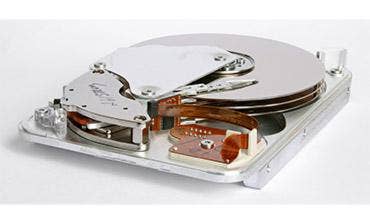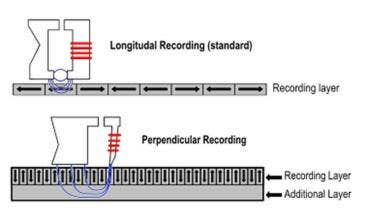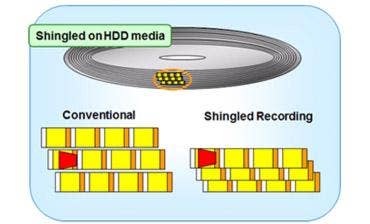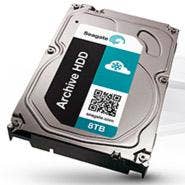The Biggest Change To HDD Tech You've Never Heard Of, Yet

The bloom is on solid state drives that are faster and more reliable, use less energy and are quieter than their geriatric brethren -- hard disk drives. But it's way too soon to say goodbye to HDDs. A technology called shingled magnetic recording (SMR) is about to reinvigorate the 50-year-old spinning disk by doubling storage capacity, without adding a penny of cost -- all the while creating new archival efficiencies in the data center.
Seagate, Toshiba and Western Digital voiced support for shingled magnetic recording in 2013, and shipped the first SMR HDD in 2015. In 2016, the drive technology is expected to achieve widespread adoption, with a bevy of commercial and consumer drives hitting the market.
SMR is the biggest update to disk storage in the past 10 years, when perpendicular drive technology was introduced, said Scott Wright, director, disk drive product marketing for Toshiba America Electronic Components.
[Related: SC15: Performance Storage Solutions For Supercomputing]
SMR is a new way to cram more data onto the same physical space on a hard drive's disk, also called a platter. The SMR breakthrough is the latest HDD advancement building on past storage technologies, including longitudinal magnetic recording, to present day perpendicular magnetic recording.
"This is a win-win for the storage industry," Wright said. "Laptop owners will see HDD storage double, with zero added cost, and enterprise customers will see double density without doubling power or data center footprint."
But here is the catch: While SMR technology boosts capacity, it reduces speed. In today's competitive storage market, where milliseconds matter, that relegates SMR specific use case scenarios to tasks such as archiving, cold storage and backup.
Here is how SMR storage differs from what has come before.

As the names implies, the predecessor longitudinal storage writes data to what is called a recording layer one block of data at a time -- similar to laying one book flat next to another on a shelf. Then in 2006 came perpendicular storage technology, which flipped the recording layer on a 90-degree angle (like standing a book upright) creating huge efficiencies. Instead of stacking data blocks flat, with perpendicular storage, blocks of data are stored like upright books on shelf. Hard drive capacity jumped from 50 GB to 500 GB.

Now with shingled magnetic recording, data is stored in blocks that overlap one another like shingles on a roof. That allows twice as much data to be stored in the same physical space. Seagate, for example, says its SMR drives can store 1.33 TB of data, compared with its perpendicular drives with a capacity of 500 GB.
Consumers will start to see SMR drives show up in notebooks later this year. Seagate has revealed its first 2.5-inch notebook drive, which begin shipping at the end of February. Toshiba and Western Digital say they are prepping notebook drives as well. Next, it's up to notebook makers such as Dell, HP Inc. and Lenovo to start adding them to their notebook SKUs.
"SMR holds tremendous potential for overall hard drive capacity gains in the year ahead," Wright said. SMR drives are fast enough for consumer applications, he said, allowing notebook makers to deliver additional value at no extra cost. That said, it's still a question mark whether notebook users are clamoring for more capacity at average HDD speeds.
Today, you can buy external SMR portable desk drives. Seagate is first to market, introducing SMR desktop small brick-sized portable drives last year. In 2016, Seagate will up the SMR ante when it introduces the SMR in a slim, pocket-sized 2.5-inch portable desktop drive called the Backup Plus Portable (4 TB).
Besides doubling storage capacity at no additional cost, Seagate says its SMR drives deliver about 15 percent higher HDD typical workload performance, compared with today's HDD status quo. Seagate says it's able to achieve these gains by tweaking firmware, allowing for more efficient sequential writes.
Speed Bumps Make SMR Ideal For Enterprise Backup
But the notebook and portable drive market is only part of how SMR will potentially change the HDD storage landscape. SMR drive technology used for data archiving shows the most promise. Drive makers say SMR is designed to meet the needs of data centers (both on-premise and in the cloud) for archiving, cold storage and backing up data. The storage technology allows them to add capacity without having to add cooling costs or a data centers' physical size.
SMR technology is a great fit for applications, such as backup, archival tasks, videos and photo storage, Wright said. Because of the unique shingled architecture of SMR, data must be more carefully written in sequential blocks to an HDD as opposed to perpendicular drives that randomly write data to a hard drive. Sequentially writing data to a hard drive allows for more capacity and prevents data blocks from accidentally being overwritten, he said.
But just as overstuffing a suitcase for vacation requires careful packing skills, so does unpacking the suitcase. SMR suffers a similar disadvantage, delivering slow performance in some workloads because of overlapping data tracks. It requires an HDD management layer for SMR drives that carefully reads and writes data to and from the drive.
This flavor of SMR HDD is called drive-managed, meaning the drive handles the packing and unpacking of data independent of the operating system. Consequently, that adds a nanosecond of time to an SMR drive's performance, making it best-suited for archiving as opposed to fast data retrieval.

Seagate's commercial SMR 3.5-inch 8 TB Archive HDD have been available for enterprise use since 2015. The drives utilize Seagate's own drive-managed SMR firmware. The drives are optimized for use in large-scale data centers for archiving and cold storage data retrieval.
Western Digital has begun shipping its Ultrastar Archive Ha 10 TB 3.5-inch archive 7200 RPM drives using platters with shingled magnetic recording. Unlike a drive-managed SMR HDD, WD uses host-managed SMR. What that means is the operating system needs to be know how to write data to the SMR drive. That rules out these host-managed drives as drop-in replacements for traditional enterprise drives. But, Seagate says, for hyper-scale customers who custom-build servers and modify their software stack to support the efficiencies of SMR, the HDDs are a no-brainer.
Commercial adoption of this drive technology is just ramping up, say HDD makers. Boulder, Colo.-based Spectra Logic was one of the first commercial rollouts of SMR with its ArcticBlue disk storage system targeting high-performance computing's object storage requirements. Spectra Logic utilizes SMR disk drives for improved storage density.
As HDD makers turn to faster, more efficient solid state drive technology, hard disk drive technology still has a few tricks up its sleeve, Wright said. "HDDs have always been one of the lowest-cost media next to tape. SMR allows us to show that there is still room for innovation in spinning media," he said.
Costs of SMR technology run about 3 cents per gigabyte. Perpendicular costs are about 5 cents per gigabyte and SSDs about 20 cents per gigabyte for low-performing SSD and 40 cents per gigabyte for high-performing SSD, according to market researcher IDC.